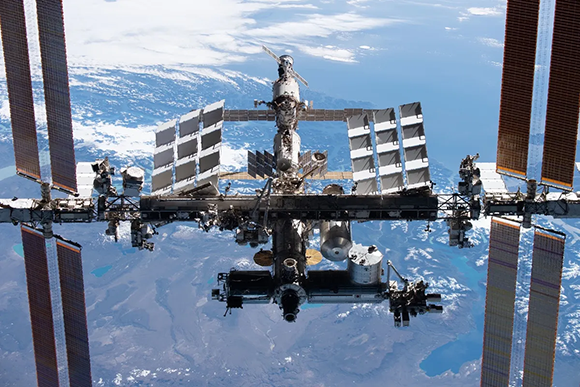Getting your Trinity Audio player ready...
First Ashdod satellite - New satellite laboratory opens in Ashdod
Last week, a new satellite lab was inaugurated in Ashdod dedicated to assembling a nano-satellite designed to test a miniature Israeli atomic clock in space. Situated in the Ashdod campus of the Shamoon College of Engineering (SCE), the lab is operated by students enrolled in the satellite engineering program. They are actively involved in programming and assembling the nano-satellite, scheduled for launch in approximately eighteen months. Currently named SCE-SAT, the satellite's primary mission is to evaluate the performance of an atomic clock developed by Jerusalem-based company Accubeat in the space environment.
Accubeat, specializing in atomic clocks, ventured into space technology by producing an exceptionally stable oscillator for the European Space Agency's JUICE mission, currently en route to explore Jupiter and its moons. Their latest product is an exceptionally accurate and tiny atomic clock, weighing only 38 grams and measuring the size of a few chocolate cubes. Current space-grade atomic clocks, such as those crucial for satellite navigation synchronization, are significantly larger and more expensive. A tiny atomic clock could be highly useful for coordinating small satellite constellations for specific observations or guiding advanced weapon systems. The SCE student satellite is intended to test the clock's durability and long-term performance in space, under extreme conditions such as near-vacuum conditions, extreme temperatures, and radiation.
8 View gallery
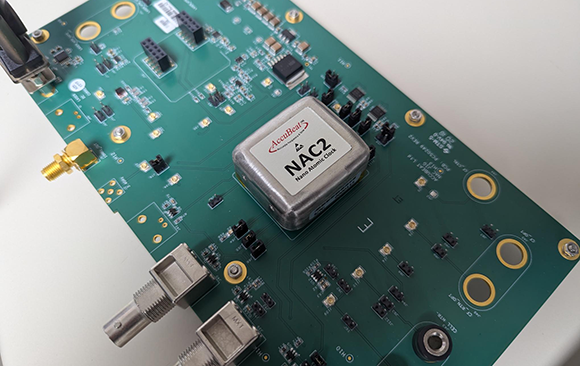

Weighing only 38 grams. Prototype of the Israeli atomic clock intended for installation in the small satellite
(Photo: Ettay Nevo)
"The idea of working with a satellite is primarily to allow students to engage in a practical project during their studies and to complete their final project on related topics such as communication, software, orbit planning, and so on," says Ori Onn, who leads the satellite initiative at the college. "It also exposes and prepares them for real work in the industry, teaches them how to work with external companies, and provides research opportunities for the college faculty."
Onn has been working in the satellite field for over twenty years, holding senior positions in several Israeli space companies. About five years ago, he established the satellite program at the college after feeling that academia was not providing adequate training for space engineers.
"All the engineers I knew in the space field stumbled into it by chance, got drawn into it, and learned on the job. But I realized there was a need for relevant education in engineering to attract students to the field during their studies." Onn developed a satellite studies program, and the Shamoon College of Engineering embraced the idea, obtaining approval from the Council for Higher Education for Israel to open a satellite track within the last three semesters of the electrical and electronics engineering degree. "We started with five students in the track five years ago; today, there are 60, with 12 of them working on their final projects in the satellite field," Onn told the Davidson Institute website.
8 View gallery
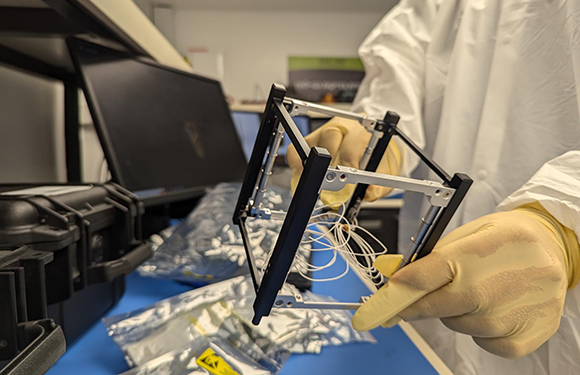

Allowing students to engage in a practical project. The SCE-SAT satellite frame, currently being assembled by college students
(Photo: Ettay Nevo)
In the newly inaugurated lab at the college, funded with over half a million NIS, the satellite frame is already taking shape - a basic 10x10x10 cm cube. Equipped with four antennas on its sides, the satellite will communicate with the ground without needing to stabilize itself in one direction, streamlining its operations. Initial tests are underway using the atomic clock prototype, with students also developing software to manage the satellite, calculate its orbit, plan power consumption, and more.
Onn is now seeking a company to launch the satellite, potentially as an additional payload in a multi-satellite mission, and is also raising funds to cover the launch costs, estimated in the tens of thousands of dollars. Pre-launch tests, including vacuum and vibration tests, will be conducted either by an external company or in a university lab. The satellite will rely on communication through existing stations of companies or other academic institutions, rather than having its own ground station.
In the future, Onn envisions expanding the program to include building and launching additional satellites with students, possibly expanding the program to a full degree in space engineering. "We offer Israeli companies the opportunity to test new space technologies on satellites we build, and they can benefit from the work of students and research projects at the college," he explained. The primary challenge, he notes, lies in integrating graduates of the program into Israeli companies within the space sector.
"With approximately 40 program graduates to date, we perceive a bias because our students come from peripheral regions, lacking degrees from prestigious institutions or experience from a military satellite unit. I expect state and government entities to support students from the southern regions and facilitate their integration into the field, rather than perpetuating disparities," emphasizes Onn. "As a smaller institution, competing for grants and R&D funding against prestigious and wealthier institutions poses challenges. Nevertheless, we are actively seeking modest investments to help integrate our graduates into the industry. It is important for both the Israeli space industry and the periphery."
8 View gallery
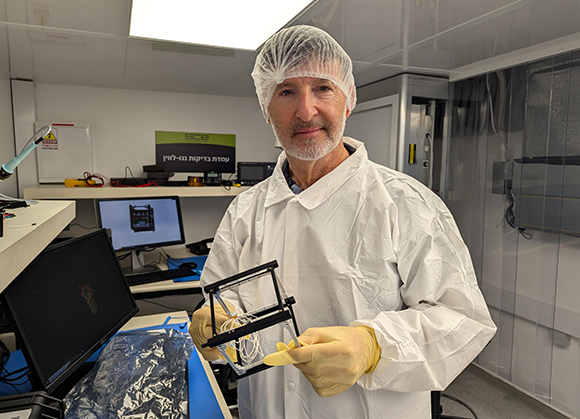

Integrating students from the periphery into the Israeli space industry remains a primary challenge. Ori Onn in the SCE satellite lab
(Photo: Ettay Nevo)
China successfully lands first samples from the far side of the Moon
China has successfully brought back the first soil samples from the far side of the Moon to Earth. The sample container from the Chang'e 6 mission was dropped as planned in the Inner Mongolia steppe region of northern China last Tuesday and was shortly thereafter collected and transferred to a scientific facility for preliminary analysis.
The Chang'e 6 mission lander collected approximately two kilograms of rocks and soil from the Apollo crater, situated in the southern part of the Moon's far side, which never faces Earth. The crater, several hundred kilometers in diameter, forms part of the Aitken Basin - a massive crater over 2,000 kilometers in diameter - formed by an asteroid impact on the Moon's far southern far side. This was only the second time a spacecraft has successfully landed on this side of the Moon, following the Chinese Chang'e 4 mission in 2019. After about two days of operation, a section of the lander took off with the sample collection container from the lunar surface and rendezvoused with the spacecraft awaiting in orbit around the Moon. At a distance of about 5,000 kilometers from Earth, the spacecraft separated from the entry module. The module, weighing about 300 kilograms including the lunar samples, re-entered the atmosphere as planned and landed in the designated area.
Video of the Moon Samples' Descent:
The sample container was flown for an initial examination and will then be transported to a laboratory in Beijing, where Chinese space program scientists will have the first opportunity to study the lunar samples. Later on, portions of the samples may later be shared with other scientists from the international community, similar to China's approach with samples from the Chang'e 5 mission in 2020.
Researchers hope that the samples will help us better understand the geological differences between the two sides of the Moon and, through this, learn about our neighbor's geological history and improve our understanding of how it was formed.
"The Moon’s geological features are highly uneven. The far side of the moon differs significantly from the near side. The far side, affected by the South Pole-Aitken basin impact and lacking extensive maria regions, suggests that its geological evolution process is different from that of the near side," noted Xiao Long, a planetary geoscientist at China University of Geosciences in Wuhan. "Obtaining samples from the far side with a determined geological context is crucial for revealing the moon’s geological history," said Long.
While geologists try to decipher the Moon's past, China's space engineers are pushing forward with future missions. In 2026, China plans to land the Chang'e 7 mission near the Moon's south pole, at the edge of the Shackleton Crater, an area exposed to perpetual sunlight. The mission is expected to deploy a lander, a rover, and a rocket-propelled drone to explore the surroundings, along with a satellite that will orbit the Moon.
This mission will pave the way for the Chang'e 8 mission, scheduled for 2028, in which China intends to test the extraction of materials from local resources. Initially, they will likely focus on extracting water, oxygen, and hydrogen from ice in the permanently shadowed craters. These two missions are intended to lay the groundwork for China's plan to land humans on the Moon and eventually establish a manned base there.
8 View gallery


Approximately two kilograms of the first samples from the far side await scientific examination. The Chang'e 6 re-entry module shortly after landing in the Inner Mongolia steppe region
(Photo: CCTV/framegrab)
Abandoning the suits
Collins Aerospace has opted to withdraw from its agreement with NASA and discontinue the development of new spacesuits, two years after being selected by NASA for the project. "After a thorough evaluation, Collins Aerospace and NASA mutually agreed to descope Exploration Extravehicular Activity Services (xEVAS) task orders. Collins remains committed to supporting NASA and human spaceflight programs," the company announced.
Two years ago, NASA had selected Collins Aerospace and Axiom Space, the latter also constructing a private space station modeled after the International Space Station, to develop the next generation of spacesuits. Axiom was tasked with developing suits for lunar activities, while Collins was selected to develop suits for extravehicular activities outside the space station. However, last year, NASA invited both companies to submit proposals for adapting the suits they are developing for both purposes.
In a departure from previous agreements, NASA did not intend to purchase the suits outright but rather to acquire them in the form of a service provided by the external companies. The suits would remain company property, allowing them to be sold to other entities. Completing the development phase could potentially secure Collins Aerospace and Axiom Space billions of dollars in work orders from NASA.
Collins Aerospace did not disclose the specific reason for its withdrawal from the spacesuit project. Only about four months ago, the company reported having completed the testing phase of its new suit during flights simulating short periods of weightlessness. Industry sources speculated that budget overruns and development schedule delays may have played a role.
NASA responded to the announcement with a brief statement confirming Collins would cease working on the suits, without specifying on plans to seek another spacesuits manufacturer. This announcement coincides with recent issues NASA faced with its current suits, including canceling two spacewalks due to malfunctions aboard the International Space Station.
Meanwhile, SpaceX is independently developing new spacesuits. So far, its astronauts have worn suits in Dragon spacecraft that connect to the ship's systems and are not intended for extravehicular activity. SpaceX plans to test the new suits on the Polaris Dawn mission, which is anticipated to include the first private astronaut spacewalk, though a date has yet to be scheduled.
8 View gallery
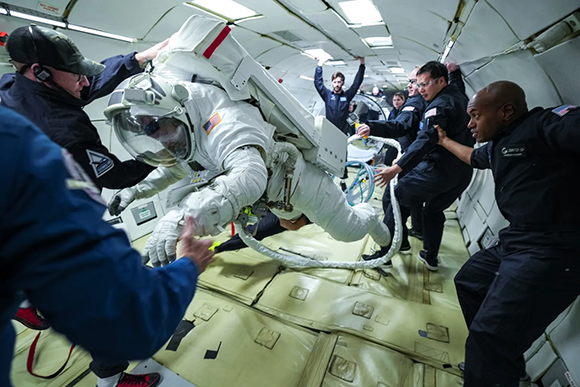

Progress appeared promising. Testing the Collins Aerospace suit in an aircraft that allows short microgravity simulations
(Photo: Collins Aerospace)
Meanwhile at the station…
Astronauts at the International Space Station (ISS) were instructed this week to take shelter in protected areas due to concerns about a potential collision of the station with space debris. The protected areas in such cases are the spacecraft docked at the station, a measure intended to allow the astronauts to quickly escape in case of significant damage to the station. The precautionary alert was triggered by a malfunctioning satellite operating in an orbit close to the ISS, which raised fears that parts of it might break off and hit the station. After about an hour of monitoring the satellite, NASA lifted the alert, and normal activities resumed onboard the station.
Currently, the station hosts nine astronauts, including Sunita Williams and Barry Wilmore, who arrived aboard Boeing's "Starliner" spacecraft on its inaugural crewed test flight. The return of the "Starliner" has been delayed due to malfunctions discovered in it.
Originally scheduled for a week-long stay, the Starliner has remained docked for nearly a month, with no return date set. The "Starliner" was launched despite a small helium leak detected in one of its thruster tanks, but additional leaks were discovered en route to the station, and another thruster stopped functioning for separate reasons.
Boeing states that most of the leaks have been resolved, with only one of 28 thrusters remaining inactive, which does not compromise flight safety. However, both Boeing and NASA have deferred the spacecraft's return, using the extended stay to thoroughly investigate the issues.
As long as the spacecraft is docked at the station, NASA can ignore the elephant in the room and has not yet addressed whether it will approve Boeing for crewed flights to the station or require another test flight. Boeing, also contending with challenges in the civil aviation sector, has invested billions of dollars in spacecraft development under its agreement with the space agency, anticipating profit from transporting astronauts and supplies to the station. Delays in realizing these plans could deal a significant financial blow to the company.
8 View gallery
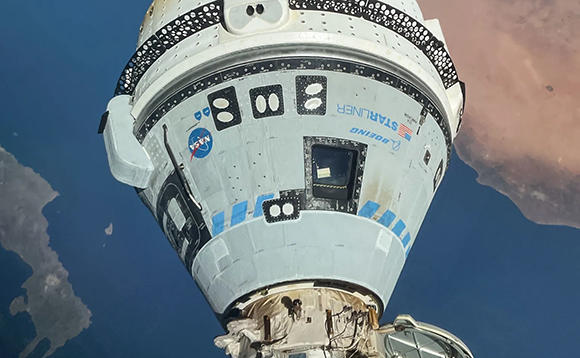

Leaks resolved, but no rush to depart. Boeing's Starliner spacecraft docked at the International Space Station
(Photo: NASA)
SpaceX's tug
The U.S. National Aeronautics and Space Administration (NASA) has chosen SpaceX to develop a specialized tug spacecraft designed to ensure the safe disposal of the International Space Station (ISS) after its operational lifespan. The station is expected to remain operational until 2030, with Axiom Space planning to develop a private space station based on its structure.
Once the private station becomes independent, NASA plans for the tug spacecraft to maneuver the ISS—either as a single unit or in separate modules—into an orbit that ensures its maximum burn-up upon re-entry into Earth's atmosphere, with the remaining debris falling in a remote ocean area, minimizing any risk to humans.
The development cost of the tug spacecraft is estimated at $843 million. Rather than outsourcing the service, NASA intends to procure and manage the spacecraft. Various options were considered for the ISS's final disposition, including moving it to a higher orbit using a tug spacecraft. However, NASA concluded that guiding it to destruction by controlled atmospheric re-entry is the most practical and safest option. NASA may also find future utility in Earth's orbit for tasks such as orbital traffic management or the removal of large space debris.
And here’s the forecast…
SpaceX has successfully launched the new weather satellite for the National Oceanic and Atmospheric Administration (NOAA). The GOES-U satellite was launched from the Kennedy Space Center in Florida aboard a Falcon Heavy rocket, marking the tenth launch of this heavy-lift rocket and maintaining a perfect record of successful launches.
The satellite, weighing five tons at launch (including two tons of fuel), was placed in a geostationary orbit 36,000 kilometers above Earth. In this orbit, its orbital period matches Earth's rotation, keeping it continuously positioned over the same area.
This is the fourth and last satellite in the current GOES series. Satellites in this orbit are used for monitoring environmental phenomena and weather forecasting and have been operating for several decades. Among other things, they monitor conditions for the development of tropical storms, track atmospheric processes, and provide real-time alerts on solar storms.
The newly launched satellite is expected to undergo more than half a year of calibration and testing before officially starting its mission, using its instruments to monitor large regions of the Western Hemisphere. The GOES satellite series is slated to operate until the next decade when they will be gradually replaced by more advanced GeoXO satellites.
8 View gallery
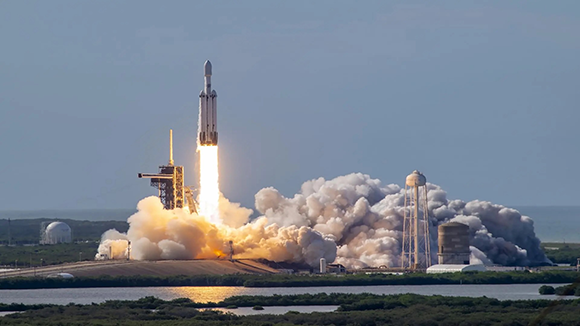

A tenth successful launch for Falcon Heavy, this time with a large weather satellite. Launch from the space center in Florida
(Photo: SpaceX)


